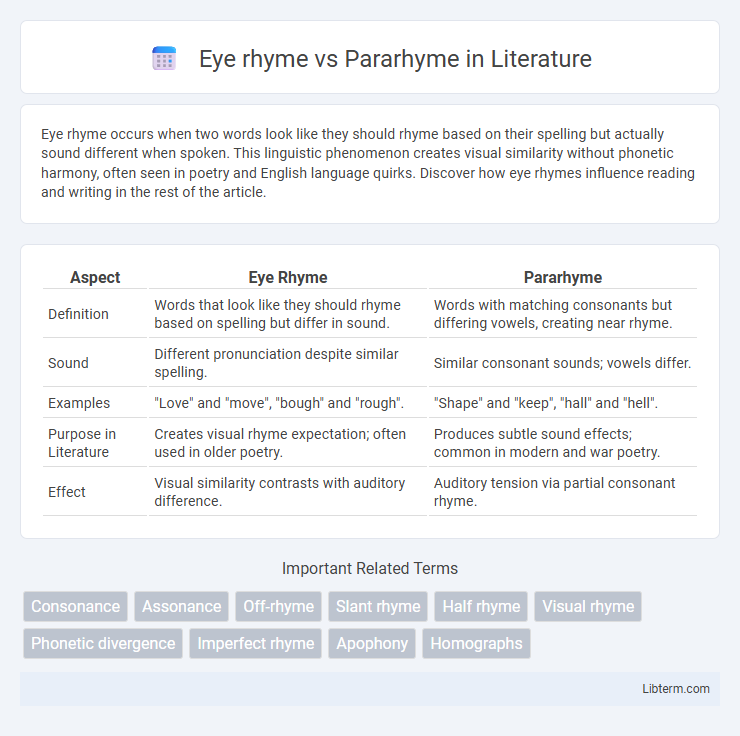Eye rhyme occurs when two words look like they should rhyme based on their spelling but actually sound different when spoken. This linguistic phenomenon creates visual similarity without phonetic harmony, often seen in poetry and English language quirks. Discover how eye rhymes influence reading and writing in the rest of the article.
Table of Comparison
| Aspect | Eye Rhyme | Pararhyme |
|---|---|---|
| Definition | Words that look like they should rhyme based on spelling but differ in sound. | Words with matching consonants but differing vowels, creating near rhyme. |
| Sound | Different pronunciation despite similar spelling. | Similar consonant sounds; vowels differ. |
| Examples | "Love" and "move", "bough" and "rough". | "Shape" and "keep", "hall" and "hell". |
| Purpose in Literature | Creates visual rhyme expectation; often used in older poetry. | Produces subtle sound effects; common in modern and war poetry. |
| Effect | Visual similarity contrasts with auditory difference. | Auditory tension via partial consonant rhyme. |
Introduction to Eye Rhyme and Pararhyme
Eye rhyme involves words that appear to rhyme due to similar spelling but have different pronunciations, such as "love" and "move," highlighting visual similarity over phonetic match. Pararhyme features consonant sounds that match while vowel sounds differ, creating a subtle, often unsettling effect, as seen in pairs like "hill" and "hell." Both techniques enrich poetic texture by playing with readers' expectations of rhyme based on spelling and sound patterns.
Defining Eye Rhyme
Eye rhyme refers to a visual similarity between words that appear to rhyme based on spelling but differ in pronunciation, such as "love" and "move." Pararhyme, in contrast, involves consonant sounds that match while vowel sounds differ, creating a partial rhyme often found in poetry. Understanding eye rhyme emphasizes the importance of orthographic appearance over phonetic accuracy in poetic structures.
Defining Pararhyme
Pararhyme is a poetic device where words share identical consonant sounds but differ in vowel sounds, creating a subtle, dissonant rhyme effect. Unlike eye rhyme, which relies on visual similarity of word endings without phonetic match, pararhyme emphasizes sonic patterns that evoke tension and complexity in verse. This technique, often used in modern and war poetry, enhances mood and rhythm through partial phonetic repetition.
Historical Origins and Literary Use
Eye rhyme, originating in Middle English poetry, appears similar in spelling but differs in pronunciation, reflecting historical shifts in phonetics and orthography; notable in works like Shakespeare's sonnets, it exploits visual similarity for subtle poetic effect. Pararhyme, rooted in early 20th-century modernist literature, especially in poets like Wilfred Owen, involves consonantal correspondences with differing vowels, creating a dissonant, haunting sound that enhances thematic tension. Both rhyme types illustrate evolving linguistic awareness in literary history, serving distinct aesthetic and emotive purposes across eras.
Visual vs. Auditory Similarity
Eye rhyme relies on visual similarity, where words appear to rhyme based on spelling but do not sound alike, as seen in pairs like "love" and "move." Pararhyme depends on auditory similarity, featuring consonant matching with differing vowel sounds, creating a subtle rhyme effect exemplified by "tell" and "tall." Understanding these distinctions highlights how poets manipulate visual and auditory elements to enrich poetic texture.
Examples of Eye Rhyme in Poetry
Eye rhyme occurs when words look similar but sound different, such as "love" and "prove," frequently used by poets like Shakespeare in sonnets to create visual rhyme harmony. Another example appears in Thomas Gray's "Elegy Written in a Country Churchyard" with "cough" and "bough," highlighting spelling-based rhyme without auditory matching. These eye rhymes contrast with pararhyme, which relies on partial consonant sound matching for a more subtle phonetic effect.
Examples of Pararhyme in Poetry
Pararhyme in poetry features consonant sounds that match while vowels differ, creating a subtle and unsettling effect, as seen in Wilfred Owen's "Strange Meeting" with pairs like "hall" and "hell." This technique contrasts with eye rhyme, where words look similar but sound different, such as "love" and "move." Poets use pararhyme to evoke tension and complexity, enriching the poem's mood through imperfect but deliberate sound patterns.
Effects on Poetic Rhythm and Mood
Eye rhyme creates a visual expectation of rhyme without the corresponding sound, subtly disrupting the rhythmic flow and evoking a sense of unease or surprise in the poem's mood. Pararhyme, with its partial consonant matches and differing vowels, intensifies tension and ambiguity, producing a staccato rhythm that enhances an unsettling or complex emotional atmosphere. Poets use eye rhyme to challenge auditory patterns and pararhyme to deepen the sonic texture, both techniques strategically shaping the reader's rhythmic experience and emotional response.
Eye Rhyme and Pararhyme in Modern Literature
Eye rhyme, characterized by words that appear to rhyme visually but differ phonetically, plays a subtle role in modern literature by challenging traditional rhyme schemes and enhancing visual poetry aesthetics. Pararhyme, involving consonant repetition with varying vowels, is employed by contemporary poets like Wilfred Owen to create tension and dissonance, reflecting emotional or thematic complexity. Together, eye rhyme and pararhyme expand the expressive potential of rhyme, contributing to innovative poetic forms in 21st-century works.
Choosing Between Eye Rhyme and Pararhyme
Choosing between eye rhyme and pararhyme depends on the desired auditory effect and visual appearance in poetry. Eye rhyme creates a visual match between words that differ in sound, making it effective for surprising or ironic emphasis. Pararhyme, involving consonant matches with differing vowels, generates a tense, unresolved tone ideal for creating mood and complexity in verse.
Eye rhyme Infographic

 libterm.com
libterm.com